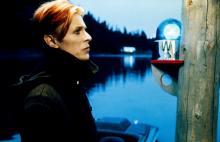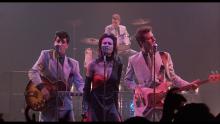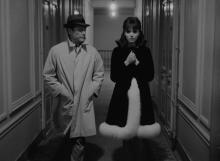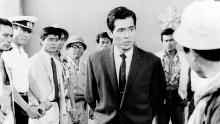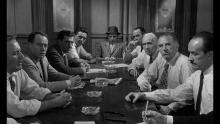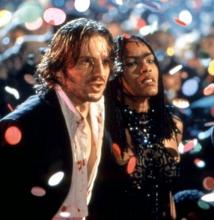The following notes on The Man Who Fell to Earth were written by Max Kaplan, PhD student in the Department of Communication Arts at UW Madison. A 35mm print of The Man Who Fell to Earth will be the final screening in our Cinematic Messages from Our Planet series at the Chazen Museum of Art on Sunday, April 28 at 2 p.m. The Chazen is located at 750 University Avenue. Admission is free.
By Max Kaplan
For a man who went by many names as a musical artist, David Bowie assumed many more throughout his cinematic career. While his film credits notably spawned fantastical creations such as Jareth, The Goblin King in Labyrinth (1986) and the vampire cellist John Blaylock in The Hunger (1983), Bowie also stepped into other uniforms (and dimensions) as Major Jack Celliers in Merry Christmas Mr. Lawrence (1983) and the enigmatic Agent Phillip Jeffries in Twin Peaks: Fire Walk with Me (1992). Meanwhile, Hollywood’s fascination with Bowie’s star power led to him being cast in larger-than-life historical roles, such as Pontius Pilate in The Last Temptation of Christ (1988), Andy Warhol in Basquiat (1996), and Nikola Tesla in The Prestige (2006). Yet much of Bowie’s brilliance could be attributed to his capacity to juggle such eclectic roles alongside his already highly conceptual persona as a pop auteur. As Katherine Reed notes, “For many entertainers, such malleability of not only character but self would be seen as a liability. Bowie sought to capitalize upon it.” The Man Who Fell to Earth (1976) marked Bowie’s foray into feature film stardom. Even more so than his filmic roles of the 80s and beyond, his appearance in Nicolas Roeg’s arthouse sci-fi classic felt strategically aligned with the otherworldly persona he’d spent the better half of a decade cultivating. Depending on how one looks at it, The Man Who Fell to Earth could even be regarded as the one true “David Bowie film.”
In 1976—and in typically cryptic Bowie fashion—Bowie proclaimed that he had “been making films on records for years now.” Before ‘high concept’ became a Hollywood buzzword, David Bowie was churning out conceptual, cinematic rock albums like The Rise and Fall of Ziggy Stardust and the Spiders from Mars (1972), Aladdin Sane (1973), and Diamond Dogs (1974). With 1975’s Young Americans, Bowie ditched his British glam rock roots for the American soul idiom, trading the sci-fi gimmick for cocaine-fueled American hedonism—foretelling a critical dichotomy at play throughout The Man Who Fell to Earth. Bowie, in fact, began work on a soundtrack for the film, originally intended as his follow-up to Young Americans, but the album fell through due to reports of drug-induced fatigue and contractual disputes. What remained from the aborted sessions were several breakthroughs that would inflect Bowie’s later sonic endeavors: namely, an interest in creating atmospheric “mood music” as well as a first inkling of collaborating with the wizard of atmospherics himself, Brian Eno. But these artistic breakthroughs would not find full bloom until Bowie’s legendarily drugged-out recording sessions in Berlin.
Like Bowie, director Nicolas Roeg was an Englishman with a cosmopolitan impulse. Roeg began his career as a cinematographer, working second unit on films like Lawrence of Arabia (1962) before graduating to director of photography for Roger Corman’s Masque of the Red Death (1964). Following his leap to directing with the East London crime drama Performance (1970)—which starred Mick Jagger—Roeg traveled to Australia and Venice, respectively, to shoot Walkabout (1971) and Don’t Look Now (1973). With his first filmed-in-America production, Roeg was seduced by the vastness of the western landscape that many New Hollywood auteurs (Malick, Altman, Bogdanovich, and others) had mined for cinematic gold. Yet for as many hallmarks of the New Hollywood style that Roeg conjures, The Man Who Fell to Earth feels more in tune with the alien perspective of an international production, feasting on the absurdity of American society from a position of other-worldly alterity.
The Man Who Fell to Earth is science fiction in name and scope, but in both sound and vision, it bears the idiosyncratic artistic trademarks of its times. Doing double duty on the soundtrack is John Phillips, of The Mamas & the Papas fame, and Stomu Yamashta, the Japanese experimental percussionist who previously created the eerie, pastoral soundscapes for Robert Altman’s Images (1972). In relieving soundtrack duty from Bowie himself, Phillips’ tunes run across the board, from the Bonnie & Clyde-esque “Bluegrass Breakdown” to the loungey jazz of “Alberto” to the space funk of “Windows.” Yamashta’s contributions inhabit the more abstract spaces of the film’s soundscape from the Western shrubland all the way to the barren terrain of Thomas Jerome Newton’s home planet, adding surreal textures to the protagonist’s disorientation. Visually, Tony Richmond’s cinematography captures the glimmering palette of boundless wealth, amusement, and alienation that subsume Newton entirely, making The Man Who Fell to Earth a film so thoroughly packed with iconic audiovisual moments. For a film that is often associated with its leading man, The Man Who Fell to Earth is an all-hands-on-deck offering of 70s auteur cinema in all its indulgent, off-kilter creativity.
Returning to Bowie, near the film’s end, we catch a brief glimpse of Bryce passing by Bowie’s Young Americans on display at a record store. However, as we soon learn, the album that attracts Bryce’s attention turns out to be a mysterious record called The Visitor, which appears to have been recorded by Newton himself. While Bowie’s music is conspicuously absent from the soundtrack, it has since become clear that the film bore a significant impact on Bowie’s musical trajectory. Fans will notice that his next two albums—Station to Station (1976) and Low (1977)—use stills from the film on their covers. Both albums now stand among Bowie’s most critically acclaimed and beloved by fans. Beyond that, Bowie’s Berlin Trilogy, beginning with 1977’s Low, ultimately allowed Bowie to not only work with Eno, but also to produce the atmospheric mood music that he had conceptualized during the production of The Man Who Fell to Earth. But what really makes the film the ‘most Bowie’ in terms of his film roles lies in the character of Thomas Newton, who subsequently became subsumed in what Lisa Perrott calls the ‘loose continuity’ of Bowie’s iconography. Joining the ranks of Major Tom, Ziggy Stardust, Halloween Jack, The Thin White Duke, Pierrot and other Bowie characters that recur throughout his transmedial oeuvre, the specter of Newton leaves a hauntological trace throughout Bowie’s subsequent work, notably being referenced in later music videos for “Little Wonder” and “No Plan.”
Around the film’s midway point, Newton tells a baffled Bryce that yes, in fact, “there have always been visitors.” Following Bowie’s untimely death in 2016, admirers and critics alike have sought meaning in his otherworldly artistic vision, looking to his music, painting, stage, and film careers for glimpses of the man behind the many guises. The Man Who Fell to Earth offers no clear-cut answers, but through it, we can relish a cinematic vision that solidified Bowie’s multifaceted star persona and inspired a whole generation of visitors to explore new audiovisual realms.

